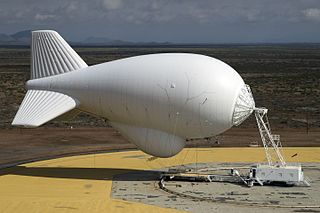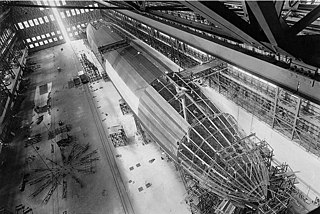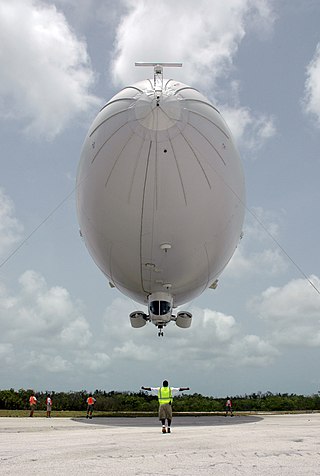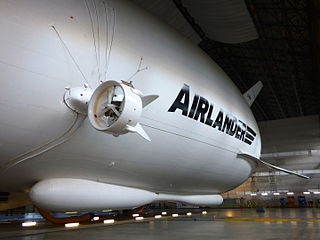
An aircraft is a vehicle that is able to fly by gaining support from the air. It counters the force of gravity by using either static lift or the dynamic lift of an airfoil, or, in a few cases, direct downward thrust from its engines. Common examples of aircraft include airplanes, helicopters, airships, gliders, paramotors, and hot air balloons.

A blimp (/blɪmp/), or non-rigid airship, is an airship (dirigible) without an internal structural framework or a keel. Unlike semi-rigid and rigid airships, blimps rely on the pressure of the lifting gas inside the envelope and the strength of the envelope itself to maintain their shape. Blimps are known for their use in advertising, surveillance, and as observation platforms due to their maneuverability and steady flight capabilities.

An airship or dirigible balloon is a type of aerostat or lighter-than-air aircraft that can navigate through the air under its own power. Aerostats gain their lift from a lifting gas that is less dense than the surrounding air.

The Zeppelin NT is a class of helium-filled airships being manufactured since the 1990s by the German company Zeppelin Luftschifftechnik GmbH (ZLT) in Friedrichshafen. The initial model is the N07. The company considers itself the successor of the companies founded by Ferdinand von Zeppelin which constructed and operated the very successful Zeppelin airships in the first third of the 20th century. There are, however, a number of notable differences between the Zeppelin NT and original Zeppelins as well as between the Zeppelin NT and usual non-rigid airships known as blimps. The Zeppelin NT is classified as a semi-rigid airship.

An aerostat is a lighter-than-air aircraft that gains its lift through the use of a buoyant gas. Aerostats include unpowered balloons and powered airships. A balloon may be free-flying or tethered. The average density of the craft is lower than the density of atmospheric air, because its main component is one or more gasbags, a lightweight skin containing a lifting gas to provide buoyancy, to which other components such as a gondola containing equipment or people are attached. Especially with airships, the gasbags are often protected by an outer envelope.

Cargolifter AG was a German company founded in 1996 to offer logistical services through point-to point transport of heavy and outsized loads. This service was based on the development of a heavy lift airship, the CL160, a 550,000 m3 (19,000,000 cu ft) vessel designed to carry a 160 t payload. The airship was never built and the company went bankrupt in July 2002. Today, shareholder-founded CL CargoLifter GmbH & Co. KG company seeks to continue selling the lighter-than-air technology. CargoLifter and Russia’s Aerosmena are among those developing huge airships that can lift up to 600 tons of freight while hovering above the ground or sea.

A hybrid airship is a powered aircraft that obtains some of its lift as a lighter-than-air (LTA) airship and some from aerodynamic lift as a heavier-than-air aerodyne.

The Goodyear Blimp is any one of a fleet of airships operated by the Goodyear Tire and Rubber Company, used mainly for advertising purposes and capturing aerial views of live sporting events for television. The term blimp itself is defined as a non-rigid airship—without any internal structure, the pressure of lifting gas within the airship envelope maintains the vessel's shape.
The Walrus HULA project was a DARPA-funded experiment to create an airship capable of traveling up to 12,000 nautical miles in range, while carrying 500–1000 tons of air cargo. In distinct contrast to earlier generation airships, the Walrus HULA would be a heavier-than-air vehicle and would generate lift through a combination of aerodynamics, thrust vectoring, and gas buoyancy generation and management.

A rigid airship is a type of airship in which the envelope is supported by an internal framework rather than by being kept in shape by the pressure of the lifting gas within the envelope, as in blimps and semi-rigid airships. Rigid airships are often commonly called Zeppelins, though this technically refers only to airships built by the Luftschiffbau Zeppelin company.
SkyCat is a class of proposed heavy-lift hybrid airships which derive more than half of their lift by helium buoyancy and the balance via aerodynamic lift produced by aerodynamic shaping. The SkyCat design incorporates hover cushion technology in place of wheels, allowing craft to take off and land anywhere, including remote regions without need for airports or sophisticated forward based infrastructure.

Marine Corps Air Station Tustin is a former United States Navy and United States Marine Corps air station, located in Tustin, California.

Hangar No. 1 is an airship hangar located at Naval Air Engineering Station Lakehurst in Manchester Township, in Ocean County, New Jersey, United States. It was the intended destination of the rigid airship LZ 129 Hindenburg prior to the Hindenburg disaster on May 6, 1937, when it burned while landing. Built in 1921, it is one of the oldest surviving structures associated with that period's development of lighter-than-air flight. It was designated a National Historic Landmark in 1968.

The Piasecki PA-97 Helistat was an American experimental heavy-lift aircraft, built by Piasecki by fastening four H-34J helicopters to a framework beneath a helium-inflated blimp envelope. The sole prototype was lost during a test flight, killing a test pilot and injuring another four in the course of a single incident.
The static buoyancy of airships in flight is not constant. It is therefore necessary to control the altitude of an airship by controlling its buoyancy: buoyancy compensation.

Airship Industries was a British manufacturers of modern non-rigid airships (blimps) active under that name from 1980 to 1990 and controlled for part of that time by Alan Bond. The first company, Aerospace Developments, was founded in 1970, and a successor, Hybrid Air Vehicles, remains active as of 2022. Airship Industries itself was active between 1980 and 1990.

The Hybrid Air Vehicles Airlander 10 is a hybrid airship designed and built by British manufacturer Hybrid Air Vehicles (HAV). Comprising a helium airship with auxiliary wing and tail surfaces, it flies using both aerostatic and aerodynamic lift and is powered by four diesel engine-driven ducted propellers.

The AeroLift CycloCrane was a unique US hybrid airship which adopted helicopter derived airfoil control for low speed flight manoeuvring by spinning on its axis. It was intended to be a heavy load lifter, initially aimed at the Canadian logging industry. A proof of concept vehicle flew at times during the 1980s, but no large production aircraft were built.

Dragon Dream is an experimental lighter than air (LTA) cargo rigid airship built by Worldwide Aeros Corp as a half-scale proof of concept prototype for a design which the manufacturer calls the "Aeroscraft". The development and design has been funded by the US government through the military Walrus HULA and then the "Pelican" projects.

Igor Pasternak is an American aviation entrepreneur, inventor and engineer specializing in designing and building airships. He is best known as the founder and CEO of Worldwide Aeros Corp, an American manufacturer of airships based in Montebello, California and for his research on variable buoyancy control for airships. Igor Pasternak is an advocate of the cargo airship industry and lighter-than-air flight.

















